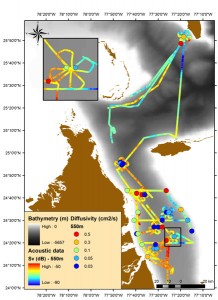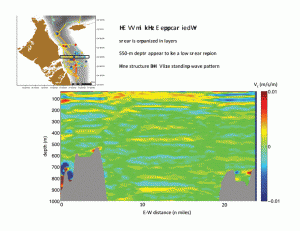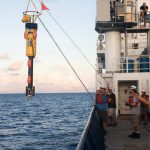Prey Fields and Habitat of Deep Divers: 3D Characterization and Modeling of Beaked and Sperm Whale Foraging Area
Beaked and sperm whales are of particular concern with regard to their sensitivity to anthropogenic noise. Assessments of the potential risk(s) of noise exposure have historically occurred in the absence of information about the physical and biological environments in which these animals are distributed and make their living diving and feeding. The DMP measures turbulent structure in the water column on the centimeter scale! The profiler is autonomous, and falls slowly through the water column once released.
When the DMP reaches its target depth, it releases weights and then floats to the surface to be recovered. In addition to measuring turbulence, the DMP measures conductivity (used to calculate salinity), temperature, and turbidity. [/note] Understanding the habits and habitats of these whales would therefore increase the effectiveness of these risk assessments.
We are investigating the biological and physical characteristics of beaked and sperm whale habitats on the U.S. Navy’s Atlantic Underwater Testing and Evaluation Center (AUTEC), located in the Bahamas in the Tongue of the Ocean (TOTO), and developing methods for long-term monitoring of this and other sensitive areas.

The tracklines of the R/V Revelle during the prey mapping.
Recent advances in the knowledge of beaked and sperm whale behavior and acoustic activity, coupled with the capabilities of the AUTEC range, allow us to track the distribution and diving and foraging behavior of the whales. Diving and acoustic behavior of individual whales will also be integrated via collaboration with existing tagging programs. The color of the track indicates the total acoustic backscatter (i.e., biomass) in the water column at 550 m depth. The clover leaf patterns, detailed in the inset, represent the area-intense sampling we conducted during the project. Guided by beaked whale foraging activity, as recorded at AUTEC, we chose these areas to measure the biomass. The clover leaf shape preserves consistent spatial and temporal sampling. The colored dots show the location of DMP samples, with the color indicating the diffusivity at 550 meters.
The primary biological property we measure is the distribution and biomass estimates of the prey field. We characterize the prey field using standard echosounder technology, though we will apply novel combinations of sensors and deploy them at depths that will permit more accurate measurements of volume backscatter at depths where these deep diving whales forage. We couple these data with measurements of several physical properties of the areas including the thermohaline structure of the water column, turbulence profiles, and vertical and horizontal current structure. All of the physical and biological data are being combined in a true 3D geospatial model which, while site specific, can be applied to larger regions. This model will be particularly useful for assessing whether a particular area of interest includes biological and physical features preferred by beaked or sperm whales.
Beaked and Sperm Whale Foraging Ecology and Habitat Characterization

Interesting shear layers in the water column.
This interdisciplinary project is focused on understanding the habitat of deep diving odontocetes, specifically integrating measurements of the biological and physical environment. Using measurements of the prey fields as well as the physical oceanographic regime, we are trying to gain a better understanding of how these deep diving whales use their environment and how that environment is organized, e.g., do physical forces cause the aggregation of certain types of biomass. As part of our interdisciplinary work to combine biological with physical sampling, we made physical oceanographic measurements with onboard acoustic doppler current profilers (ADCP) and the deep microstructure profiler. During the transect shown to the left, we found some very interesting shear layers in the water column, indicated by the varying Vz values. These shear layers could provide structure that may be exploited by beaked whales as such features may structure the prey fields. We are working to align these measurements with those from the multi-sensor tags attached to beaked whales as part of the Behavioral Response Study.
So far, we have studied beaked whales in the Tongue of the Ocean, Bahamas. At the U.S. Naval Atlantic Undersea Test and Evaluation Center (AUTEC), the Navy uses their hydrophone test range to record and, in some cases, track vocalizing animals. During an experiment to test for whales’ responses to sonar, we measured the prey fields using a 38 kHz Simrad echosounder, water column turbulence with a deep microstructure profiler, and current speeds and directions with the specialized ADCP system aboard the R/V Revelle. We then combined our measurements with the echolocation click data from the AUTEC array to examine how it varied with the physical and biological structure in the habitat.
Improving Attachments of Non-invasive Electronic Data Loggers to Cetaceans
Suction cup attachments have been used widely for the last 20 years to attach short-term archival tags to marine animals. Suction cups have proven to be a successful method for short-term attachment to many species of whales, dolphins, and turtles, and are especially valuable in cases where the recording longevity of the tag, the size or state-of-health of the study animal, or the need to recover the tag, make long-term invasive tagging inappropriate. Suction cup tags can be rapidly applied to free-swimming animals using poles or ballistic delivery methods.
The uniformly smooth surface of many marine mammals and some other marine organisms make suction cup attachments uncritical of precise placement on the body. The lack of skin penetration of the attachment and the capability to deliver tags to many species without the need for capturing individuals, make suction cup tags a critical tool for research on sensitive species or on populations for which there is strong public sensitivity.
The uniformly smooth surface of many marine mammals and some other marine organisms make suction cup attachments uncritical of precise placement on the body.
Archival tags for suction cup attachment are generally multi-sensor devices ranging from TDRs (Time-depth recorders), to fine-scale tracking devices and complex sound, image and movement recorders. High sensor sampling rates are often used to ensure that short duration behaviors and movements are sampled. An example high resolution archival tag is the Woods Hole Oceanographic Institution’s digital acoustic recording tag (DTAG). Since 1999, DTAGs have been deployed on over 500 whales from 14 different species and have produced more than n refereed journal publications. In addition to high quality sound recording, this tag incorporates a precision orientation sensor to track the movements of the animal. This versatile sensor suite has enabled a broad range of studies of marine mammal physiology and ethology ranging from studies of locomotion, foraging tactics, echolocation, sound source characteristics to acoustic detectability and response to environmental sound. Because of the high data collection rate of the tag, the recording duration is relatively short (<24 hours) making it appropriate for suction cup attachment. DTAGs are typically attached using 2-4 silicone suction cups. Multiple suction cups are necessary to ensure that the tag follows the movements of the animal accurately.
[W]e should be able to take advantage of existing chemistries either with targeted substrates and enzymes or by altering existing chemistry into a reactive form.
We are investigating the bio-physics of cup/skin interactions to identify the failure modes of current suction cup designs on cetacean skin. Models of cup and skin behavior as well as hydrodynamic drag forces on different sized and shaped packages are being tested to engineer a suction cup with enhanced reliability and longevity over current cup designs. The goal is attachment of multiple days on medium and large whales. The engineered attachments will include sensors to assess retention performance providing a more detailed view of progressive failure modes. Combining these sensor data with behavioral data collected by payload DTAGs will help uncover the factors that most contribute to attachment deterioration. The new devices will be tested in a captive setting and then deployed at sea on wild animals. We are also investigating the biochemistry of the surface of cetacean skin. We know from the literature that the surfaces of cetaceans have cellular architecture and surface chemistries similar to those of human oral cavities and the insides of blood vessels. All these unique surfaces have properties that render them near the bioadhesive minimum and refractive to most kinds of biofouling. However, given a little more detailed information about the chemical properties of these keratinized layers of dead cells, we should be able to take advantage of existing chemistries either with targeted substrates and enzymes or by altering existing chemistry into a reactive form. We are doing surface analysis of skin from stranded animals by using classic staining techniques and with surface mass spectrometry procedures to determine the functional groups of proteins and sugars at the surface of the skin.
Integrating acoustic recorders into the SeaGlider
Working with iRobot and the University of Hawaii, we are working to integrate a DMON (digital acoustic monitor) into the SeaGlider.
The Whale ‘Entangler’

Working with the Consortium for Bycatch Reduction and Bellequant Engineering, we have developed an interactive, mechanically explicit ‘video game’ that can be used to ‘reverse engineer’ entanglements of large whales in fishing gear. Large whale entanglements are common along the east coast of the U.S., some are minor but many cause significant injuries or mortality.
When whales are discovered with entanglements, significant effort is put toward understanding how and where the lines are wrapped on the animal, and this knowledge is used to strategize about whether the entanglement is life threatening and, if so, how to disentangle the whale.



